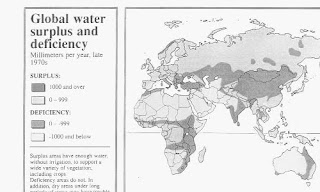
INTRODUCTION
Comprising over 70% of the Earth's surface, water is undoubtedly the most precious natural resource that exists on our planet. Without the seemingly invaluable compound comprised of hydrogen and oxygen, life on Earth would be non-existent: it is essential for everything on our planet to grow and prosper. Although we as humans recognize the
is fact, we disregard it by polluting our rivers, lakes, and oceans. Subsequently, we are slowly but surely harming our planet to the point where organisms are dying at a very alarming rate. In addition to innocent organisms dying off, our drinking water has become greatly affected as is our ability to use water for recreational purposes. In order to combat water pollution, we must understand the problems and become part of the solution.
POINT AND NONPOINT SOURCES
According to the American College Dictionary, pollution is defined as: �to make foul or unclean; dirty.� Water pollution occurs when a body of water is adversely affected due to the addition of large amounts of materials to the water. When it is unfit for its intended use, water is considered polluted. Two types of water pollutants exist; point source and nonpoint source. Point sources of pollution occur when harmful substances are emitted directly into a body of water. The Exxon Valdez oil spill best illustrates a point source water pollution. A nonpoint source delivers pollutants indirectly through environmental changes. An example of this type of water pollution is when fertilizer from a field is carried into a stream by rain, in the form of run-off which in turn effects aquatic life. The technology exists for point sources of pollution to be monitored and regulated, although political factors may complicate matters. Nonpoint sources are much more difficult to control. Pollution arising from nonpoint sources accounts for a majority of the contaminants in streams and lakes.
CAUSES OF POLLUTION
Many causes of pollution including sewage and fertilizers contain nutrients such as nitrates and phosphates. In excess levels, nutrients over stimulate the growth of aquatic plants and algae. Excessive growth of these types of organisms consequently clogs our waterways, use up dissolved oxygen as they decompose, and block light to deeper waters. This, in turn, proves very harmful to aquatic organisms as it affects the respiration ability or fish and other invertebrates that reside in water. Pollution is also caused when silt and other suspended solids, such as soil, washoff plowed fields, construction and logging sites, urban areas, and eroded river banks when it rains. Under natural conditions, lakes, rivers, and other water bodies undergo Eutrophication, an aging process that slowly fills in the water body with sediment and organic matter. When these sediments enter various bodies of water, fish respirationbecomes impaired, plant productivity and water depth become reduced, and aquatic organisms and their environments become suffocated. Pollution in the form of organic material enters waterways in many different forms as sewage, as leaves and grass clippings, or as runoff from livestock feedlots and pastures. When natural bacteria and protozoan in the water break down this organic material, they begin to use up the oxygen dissolved in the water. Many types of fish and bottom-dwelling animals cannot survive when levels of dissolved oxygen drop below two to five parts per million. When this occurs, it kills aquatic organisms in large numbers which leads to disruptions in the food chain.

ADDITIONAL FORMS OF WATER POLLUTION
active substances, and heat. Petroleum often pollutes waterbodies in the form of oil, resulting from oil spills. The previously mentioned Exxon Valdez is an example of this type of water pollution. These large-scale accidental discharges of petroleum are an important cause of pollution along shore lines. Besides the supertankers, off-shore drilling operations contribute a large share of pollution. One estimate is that one ton of oil is spilled for every million tons of oil transported. This is equal to about 0.0001 percent. Radioactive substances are produced in the form of waste from nuclear power plants, and from the industrial, medical, and scientific use of radioactive materials. Specific forms of waste are uranium and thorium mining and refining. The last form of water pollution is heat. Heat is a pollutant because increased temperatures result in the deaths of many aquatic organisms. These decreases in temperatures are caused when a discharge of cooling water by factories and power plants occurs.


Workers use special nets to clean up a California beach after an oil tanker spill. Tanker spills are an increasing environmental problem because once oil has spilled, it is virtually impossible to completely remove or contain it. Even small amounts spread rapidly across large areas of water. Because oil and water do not mix, the oil floats on the water and then washes up on broad expanses of shoreline. Attempts to chemically treat or sink the oil may further disrupt marine and beach ecosystems.
The major sources of water pollution can be classified as municipal, industrial, and agricultural. Municipal water pollution consists of waste water from homes and commercial establishments. For many years, the main goal of treating municipal wastewater was simply to reduce its content of suspended solids, oxygen-demanding materials, dissolved inorganic compounds, and harmful bacteria. In recent years, however, more stress has been placed on improving means of disposal of the solid residues from the municipal treatment processes. The basic methods of treating municipal wastewater fall into three stages: primary treatment, including grit removal, screening, grinding, and sedimentation; secondary treatment, which entails oxidation of dissolved organic matter by means of using biologically active sludge, which is then filtered off; and tertiary treatment, in which advanced biological methods of nitrogen removal and chemical and physical methods such as granular filtration and activated carbon absorption are employed. The handling and disposal of solid residues can account for 25 to 50 percent of the capital and operational costs of a treatment plant. The characteristics of industrial waste waters can differ considerably both within and among industries. The impact of industrial discharges depends not only on their collective characteristics, such as biochemical oxygen demand and the amount of suspended solids, but also on their content of specific inorganic and organic substances. Three options are available in controlling industrial wastewater. Control can take place at the point of generation in the plant; wastewater can be pretreated for discharge to municipal treatment sources; or wastewater can be treated completely at the plant and either reused or discharged directly into receiving waters.

Wastest Treatment
Agriculture, including commercial livestock and poultry farming, is the source of many organic and inorganic pollutants in surface waters and groundwater. These contaminants include both sediment from erosion cropland and compounds of phosphorus and nitrogen that partly originate in animal wastes and commercial fertilizers. Animal wastes are high in oxygen demanding material, nitrogen and phosphorus, and they often harbor pathogenic organisms. Wastes from commercial feeders are contained and disposed of on land; their main threat to natural waters, therefore, is from runoff and leaching. Control may involve settling basins for liquids, limited biological treatment in aerobic or anaerobic lagoons, and a variety of other methods.
GROUND WATER
Ninety-five percent of all fresh water on earth is ground water. Ground water is found in natural rock formations. These formations, called aquifers, are a vital natural resource with many uses. Nationally, 53% of the population relies on ground water as a source of drinking water. In rural areas this figure is even higher. Eighty one percent of community water is dependent on ground water. Although the 1992 Section 305(b) State Water Quality Reports indicate that, overall, the Nation�s ground water quality is good to excellent, many local areas have experienced significant ground water contamination. Some examples are leaking underground storage tanks and municipal landfills.
LEGISLATION

Several forms of legislation have been passed in recent decades to try to control water pollution. In 1970, the Clean Water Act provided 50 billion dollars to cities and states to build wastewater facilities. This has helped control surface water pollution from industrial and municipal sources throughout the United States. When congress passed the Clean Water Act in 1972, states were given primary authority to set their own standards for their water. In addition to these standards, the act required that all state beneficial uses and their criteria must comply with the �fishable and swimmable� goals of the act. This essentially means that state beneficial uses must be able to support aquatic life and recreational use. Because it is impossible to test water for every type of disease-causing organism, states usually look to identify indicator bacteria. One for a example is a bacteria known as fecal coliforms.(Figure 1 shows the quality of water for each every state in the United States, click on the US link). These indicator bacteria suggest that a certain selection of water may be contaminated with untreated sewage and that other, more dangerous, organisms are present. These legislations are an important part in the fight against water pollution. They are useful in preventing Envioronmental catastrophes. The graph shows reported pollution incidents since 1989-1994. If stronger legislations existed, perhaps these events would never have occurred.
figure 1
GLOBAL WATER POLLUTION
Estimates suggest that nearly 1.5 billion people lack safe drinking water and that at least 5 million deaths per year can be attributed to waterborne diseases. With over 70 percent of the planet covered by oceans, people have long acted as if these very bodies of water could serve as a limitless dumping ground for wastes. Raw sewage, garbage, and oil spills have begun to overwhelm the diluting capabilities of the oceans, and most coastal waters are now polluted. Beaches around the world are closed regularly, often because of high amounts of bacteria from sewage disposal, and marine wildlife is beginning to suffer.

Perhaps the biggest reason for developing a worldwide effort to monitor and restrict global pollution is the fact that most forms of pollution do not respect national boundaries. The first major international conference on environmental issues was held in Stockholm, Sweden, in 1972 and was sponsored by the United Nations (UN). This meeting, at which the United States took a leading role, was controversial because many developing countries were fearful that a focus on environmental protection was a means for the developed world to keep the undeveloped world in an economically subservient position. The most important outcome of the conference was the creation of the United Nations Environmental Program (UNEP).

UNEP was designed to be the environmental conscience of the United Nations,� and, in an attempt to allay fears of the developing world, it became the first UN agency to be headquartered in a developing country, with offices in Nairobi, Kenya. In addition to attempting to achieve scientific consensus about major environmental issues, a major focus for UNEP has been the study of ways to encourage sustainable development increasing standards of living without destroying the environment. At the time of UNEP's creation in 1972, only 11 countries had environmental agencies. Ten years later that number had grown to 106, of which 70 were in developing countries.
WATER QUALITY

Water quality is closely linked to water use and to the state of economic development. In industrialized countries, bacterial contamination of surface water caused serious health problems in major cities throughout the mid 1800�s. By the turn of the century, cities in Europe and North America began building sewer networks to route domestic wastes downstream of water intakes. Development of these sewage networks and waste treatment facilities in urban areas has expanded tremendously in the past two decades. However, the rapid growth of the urban population (especially in Latin America and Asia) has outpaced the ability of governments to expand sewage and water infrastructure. While waterborne diseases have been eliminated in the developed world, outbreaks of cholera and other similar diseases still occur with alarming frequency in the developing countries. Since World War II and the birth of the �chemical age�, water quality has been heavily impacted worldwide by industrial and agricultural chemicals. Eutrophication of surface waters from human and agricultural wastes and nitrification of groundwater from agricultural practices has greatly affected large parts of the world. Acidification of surface waters by air pollution is a recent phenomenon and threatens aquatic life in many area of the world. In developed countries, these general types of pollution have occurred sequentially with the result that most developed countries have successfully dealt with major surface water pollution. In contrast, however, newly industrialized countries such as China, India, Thailand, Brazil, and Mexico are now facing all these issues simultaneously.
CONCLUSION
Clearly, the problems associated with water pollution have the capabilities to disrupt life on our planet to a great extent. Congress has passed laws to try to combat water pollution thus acknowledging the fact that water pollution is, indeed, a seriousissue. But the government alone cannot solve the entire problem. It is ultimately up to us, to be informed, responsible and involved when it comes to the problems we face with our water. We must become familiar with our local water resources and learn about ways for disposing harmful household wastes so they don�t end up in sewage treatment plants that can�t handle them or landfills not designed to receive hazardous materials. In our yards, we must determine whether additional nutrients are needed before fertilizers are applied, and look for alternatives where fertilizers might run off into surface waters. We have to preserve existing trees and plant new trees and shrubs to help prevent soil erosion and promote infiltration of water into the soil. Around our houses, we must keep litter, pet waste, leaves, and grass clippings out of gutters and storm drains. These are just a few of the many ways in which we, as humans, have the ability to combat water pollution. As we head into the 21st century, awareness and education will most assuredly continue to be the two most important ways to prevent water pollution. If these measures are not taken and water pollution continues, life on earth will suffer severely. Global environmental collapse is not inevitable. But the developed world must work with the developing world to ensure that new industrialized economies do not add to the world's environmental problems. Politicians must think of sustainable development rather than economic expansion. Conservation strategies have to become more widely accepted, and people must learn that energy use can be dramatically diminished without sacrificing comfort. In short, with the technology that currently exists, the years of global environmental mistreatment can begin to be reversed.



